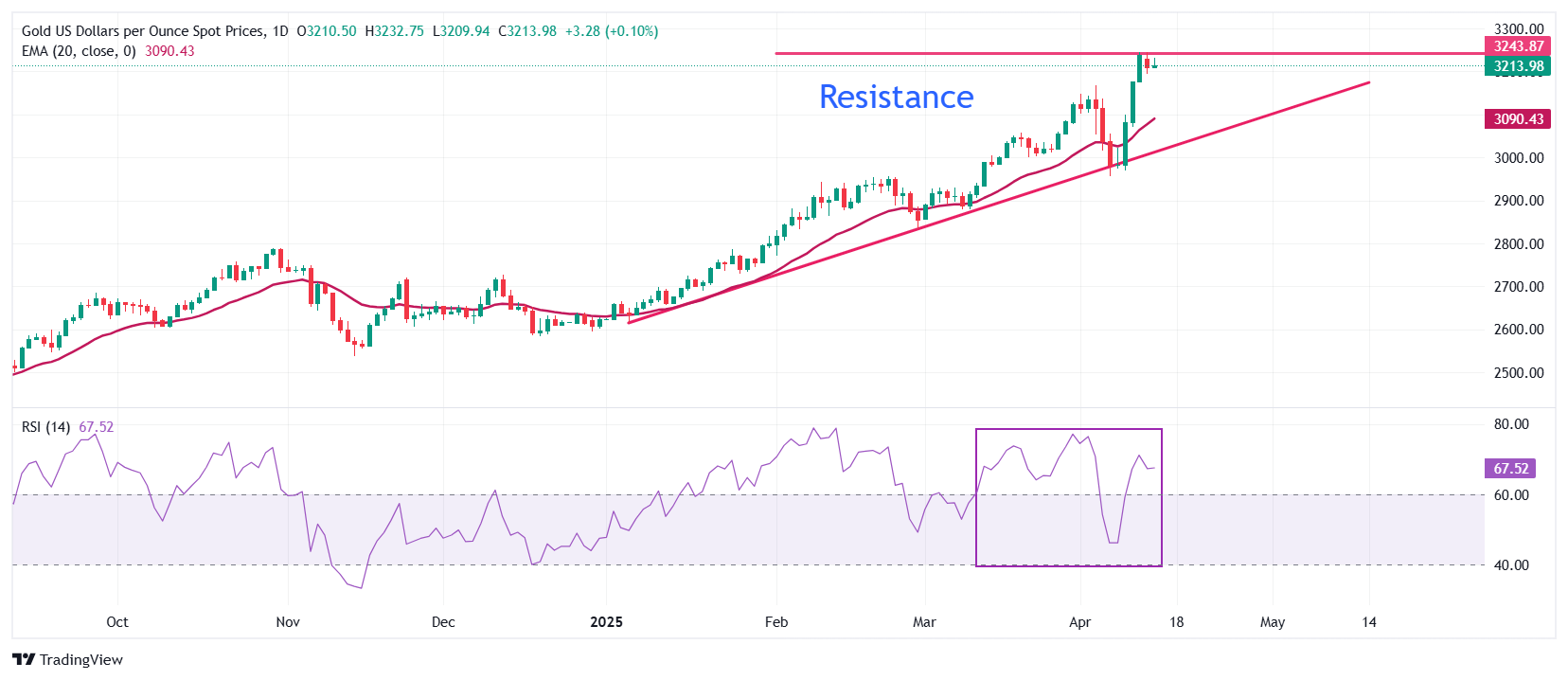Gold Price Forecast: XAU/USD holds onto gains above $3,200 on Trump’s tariff uncertainty
- Gold price grips gains above $3,200 on heightened global economic tensions.
- China would look for other markets as US importers would avoid buying products from them due to higher tariffs.
- Fed Waller backs interest rate cuts due to escalating recession risks.
Gold price (XAU/USD) clings to gains near all-time highs (ATH) around $3,245 during North American trading hours on Tuesday. The yellow metal demonstrates strength as deepening uncertainty over the global economic outlook due to United States (US) President Donald Trump’s tariff policies continues to strengthen the appeal of safe-haven assets.
Though the trade war has been confined majorly between the US and China after Trump’s declaration of a 90-day pause in the execution of reciprocal tariffs for all of his trading partners, except the Asian giant, investors still worry that the situation is painful for the global economy.
A significant increase in reciprocal tariffs on China by Trump to 125% is expected to make Chinese products less competitive for US manufacturers. This would lead Beijing to diverge to other nations for selling their products. Given that China-manufactured products are highly disruptive due to low-cost competitive advantage, businesses from other economies will face significant competition.
Technically, heightening global economic tensions improves the safe-haven demand of precious metals, such as Gold.
Meanwhile, firm market expectations that the Federal Reserve (Fed) will cut interest rates in the June meeting have also provided some strength in the Gold price. The scenario of the Fed lowering interest rates bodes well for non-yielding assets, such as Gold.
On Monday, Fed Governor Christopher Waller warned that the “new tariff policy” is one of the “biggest shocks” to affect the US economy in decades. Waller gave more weightage to brewing fears of an economic recession over accelerating inflation expectations and backed monetary policy easing.
Gold technical analysis
Gold price trades inside Monday’s trading range around $3,230 but is close to the ATH around $3,245. The outlook of the Gold price is upbeat as the 20-day Exponential Moving Average (EMA) slopes higher, trading around $3,090.
The 14-day Relative Strength Index (RSI) trades above 60.00, suggesting a strong bullish momentum.
Looking down, the 20-day EMA will act as a key support zone for the pair. On the upside, the round-level resistance of $3,300 will act as a key resistance zone.
Gold daily chart

Gold FAQs
Gold has played a key role in human’s history as it has been widely used as a store of value and medium of exchange. Currently, apart from its shine and usage for jewelry, the precious metal is widely seen as a safe-haven asset, meaning that it is considered a good investment during turbulent times. Gold is also widely seen as a hedge against inflation and against depreciating currencies as it doesn’t rely on any specific issuer or government.
Central banks are the biggest Gold holders. In their aim to support their currencies in turbulent times, central banks tend to diversify their reserves and buy Gold to improve the perceived strength of the economy and the currency. High Gold reserves can be a source of trust for a country’s solvency. Central banks added 1,136 tonnes of Gold worth around $70 billion to their reserves in 2022, according to data from the World Gold Council. This is the highest yearly purchase since records began. Central banks from emerging economies such as China, India and Turkey are quickly increasing their Gold reserves.
Gold has an inverse correlation with the US Dollar and US Treasuries, which are both major reserve and safe-haven assets. When the Dollar depreciates, Gold tends to rise, enabling investors and central banks to diversify their assets in turbulent times. Gold is also inversely correlated with risk assets. A rally in the stock market tends to weaken Gold price, while sell-offs in riskier markets tend to favor the precious metal.
The price can move due to a wide range of factors. Geopolitical instability or fears of a deep recession can quickly make Gold price escalate due to its safe-haven status. As a yield-less asset, Gold tends to rise with lower interest rates, while higher cost of money usually weighs down on the yellow metal. Still, most moves depend on how the US Dollar (USD) behaves as the asset is priced in dollars (XAU/USD). A strong Dollar tends to keep the price of Gold controlled, whereas a weaker Dollar is likely to push Gold prices up.

